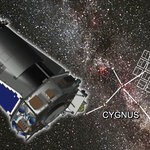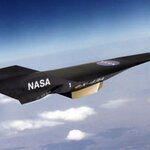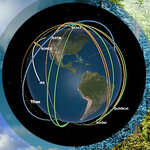Aerospace

Can you fly a house with balloons? The recent Pixar movie "Up" does, but it's animated. In the "Up" production notes, Steve May, the film's supervising technical director, writes
"It was important to the film to have fairly realistic balloon simulations. The balloons behave in a realistic way, although the notion of being able to fly a hosue with balloons is pretty preposterous. We're not physicists but one of our technical directors calculated that it would take on the order of 20 to 30 million balloons to actually life Carl's house. We ended up using [...] 20,…

Penguin poo (guano) stains, visible from space, have helped British scientists locate emperor penguin breeding colonies in Antarctica. Knowing their location provides a baseline for monitoring their response to environmental change. In a new study published this week in the journal Global Ecology and Biogeography, scientists from British Antarctic Survey (BAS) describe how they used satellite images to survey the sea-ice around 90% of Antarctica's coast to search for emperor penguin colonies. The survey identified a total of 38. Ten of those were new.
Of the previously known colonies…

GOCE (Gravity field and steady-state Ocean Circulation Explorer), launched in March and currently progressing through the commissioning phase, has achieved a first in the history of satellite technology; an electric propulsion system able to keep the satellite completely free from drag as it cuts through the remnants of Earth's atmosphere.
GOCE is set to measure Earth's gravity field with unprecedented accuracy but doing so means that the satellite has to orbit Earth as low as possible, where the gravitational signal is stronger but also where the fringes of the atmosphere remain.
To…

The dual launch of the far-infrared space telescope Herschel and cosmic background mapper Planck on an Ariane 5 rocket from Europe's Spaceport in French Guiana is the beginning of two of the most ambitious missions ever attempted to unveil the secrets of the darkest, coldest and oldest parts of the Universe. Herschel has the largest mirror ever launched into space and will examine a little known part of the electromagnetic spectrum to learn more about the birth of stars and galaxies as well as dust clouds and planet-forming discs around stars - and will look for water, a key component of…

NASA's Kepler spacecraft has begun its search for other Earth-like worlds. The mission, which launched from Cape Canaveral, Fla., on March 6, will spend the next three-and-a-half years staring at more than 100,000 stars for telltale signs of planets. Kepler has the unique ability to find planets as small as Earth that orbit sun-like stars at distances where temperatures are right for possible lakes and oceans.
Scientists and engineers have spent the last two months checking out and calibrating the Kepler spacecraft. Data have been collected to characterize the imaging performance as…

When a jet is flying faster than the speed of sound, one small mistake can tear it apart. It was so feared that the physics blended with the supernatural in the mid 1940s. Luckily, Chuck Yeager didn't believe in demons.
There was a demon that lived in the air. They said whoever challenged him would die. His controls would freeze up, his plane would buffet wildly, and he would disintegrate. The demon lived at Mach 1 on the meter, seven hundred and fifty miles an hour, where the air could no longer move out of the way. He lived behind a barrier through which they said no man would…

New interactive features on NASA's Global Climate Change Web site give the public the opportunity to "fly along" with NASA's fleet of Earth science missions and observe Earth from a global perspective in an immersive, 3-D environment.
Developed using a state-of-the-art, browser-based visualization technology, "Eyes on the Earth 3-D" displays the location of all of NASA's 15 currently operating Earth-observing missions in real time. These missions constantly monitor our planet's vital signs, such as sea level height, concentration of carbon dioxide in our atmosphere, global temperatures…

The Kepler spacecraft and its Delta II rocket have been cleared to launch into space at 10:49 p.m. EST Friday night. Its mission; watch a patch of space (see image below) for the next 3.5 years and look for signs of Earth-sized planets moving around stars similar to the sun. The area that Kepler will watch contains around 100,000 stars like the sun and Kepler will look for slight dimming in the stars as planets pass between the star and Kepler. Unlike observatories like Hubble, Kepler will be able to watch the same stars constantly throughout its mission.
Here are 5 quick facts,…

Here are some quick facts about the Earth-orbiting satellite, scheduled to launch on Feb. 24, 2009.
-- It will study carbon dioxide sources (where it comes from) and sinks (where it is pulled out of the atmosphere and stored). Carbon dioxide is a major contributor to global warming. The new data will help scientists more accurately forecast global climate change.
-- Data collected by the OCO mission may help policymakers and leaders make more informed decisions to ensure climate stability and retain our quality of life.
-- Scientists don't know why the amount of carbon…

February 20th marks a historic anniversary in the American Space Program. On this day in 1962, astronaut John Glenn boarded the Friendship 7 spacecraft and became to first American to orbit the earth as part of the successful Mercury-Atlas 6 mission.
The drive to put a man in orbit was unofficially launched years earlier, after the Soviet Union successfully launched Sputnik I on October 4, 1957. Americans suddenly found themselves "second best" in the area of space and related technologies, a position they quickly realized they didn't want to be.
However President Dwight D. Eisenhower was…